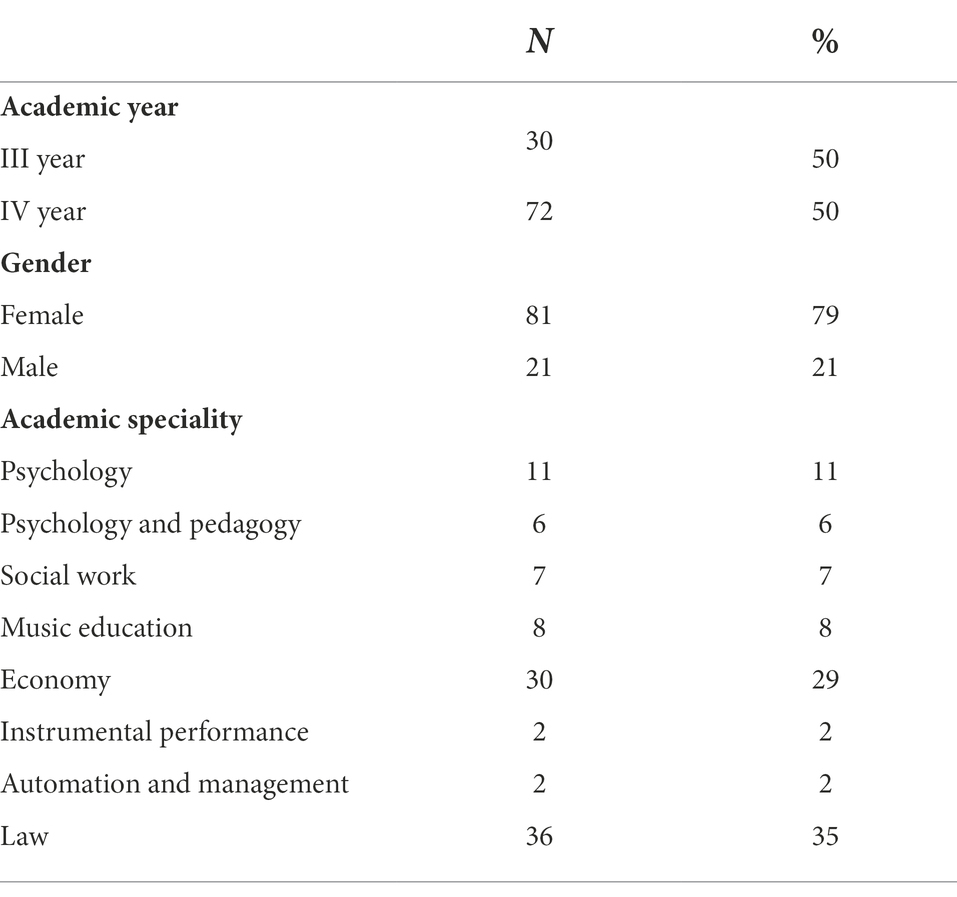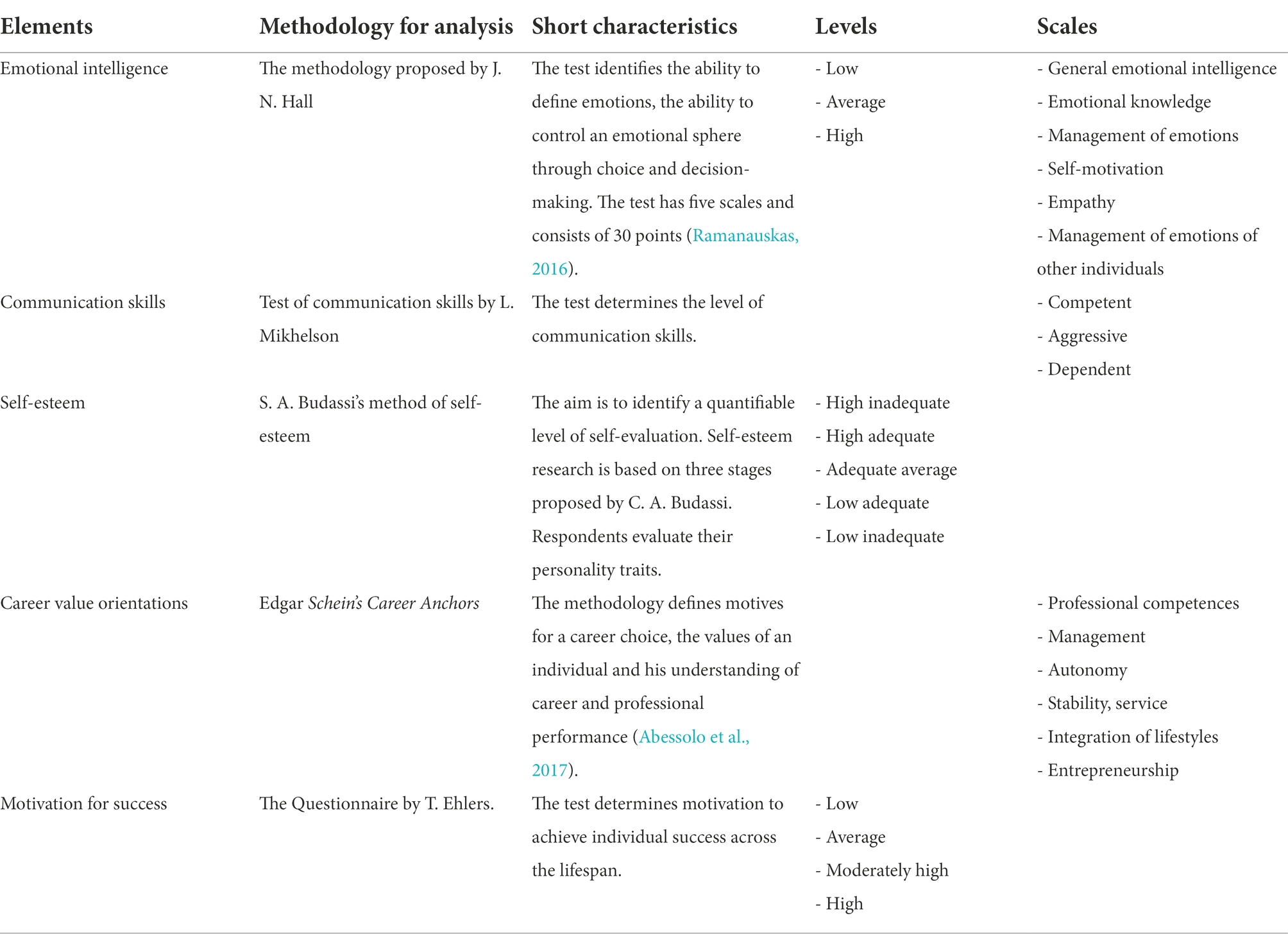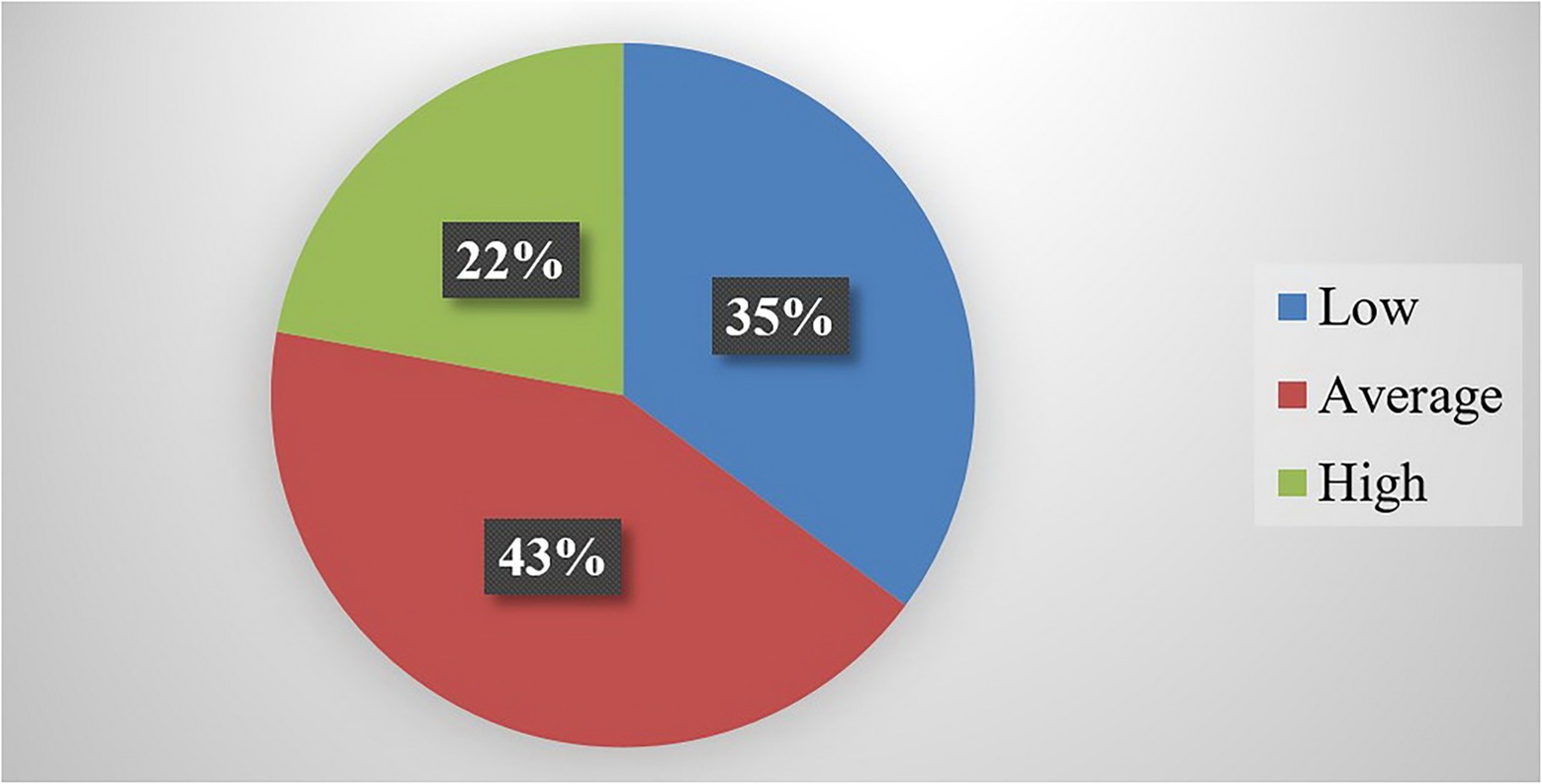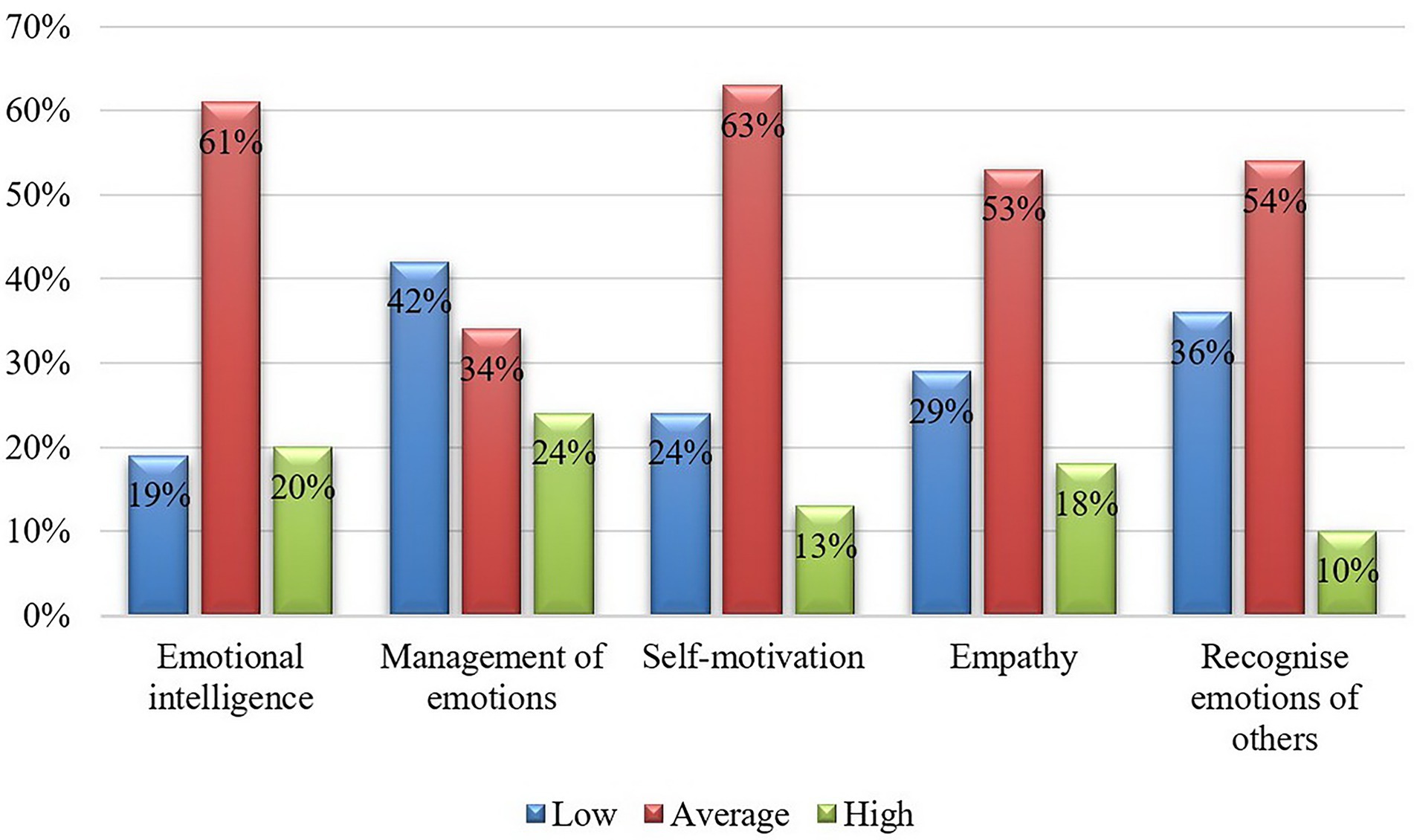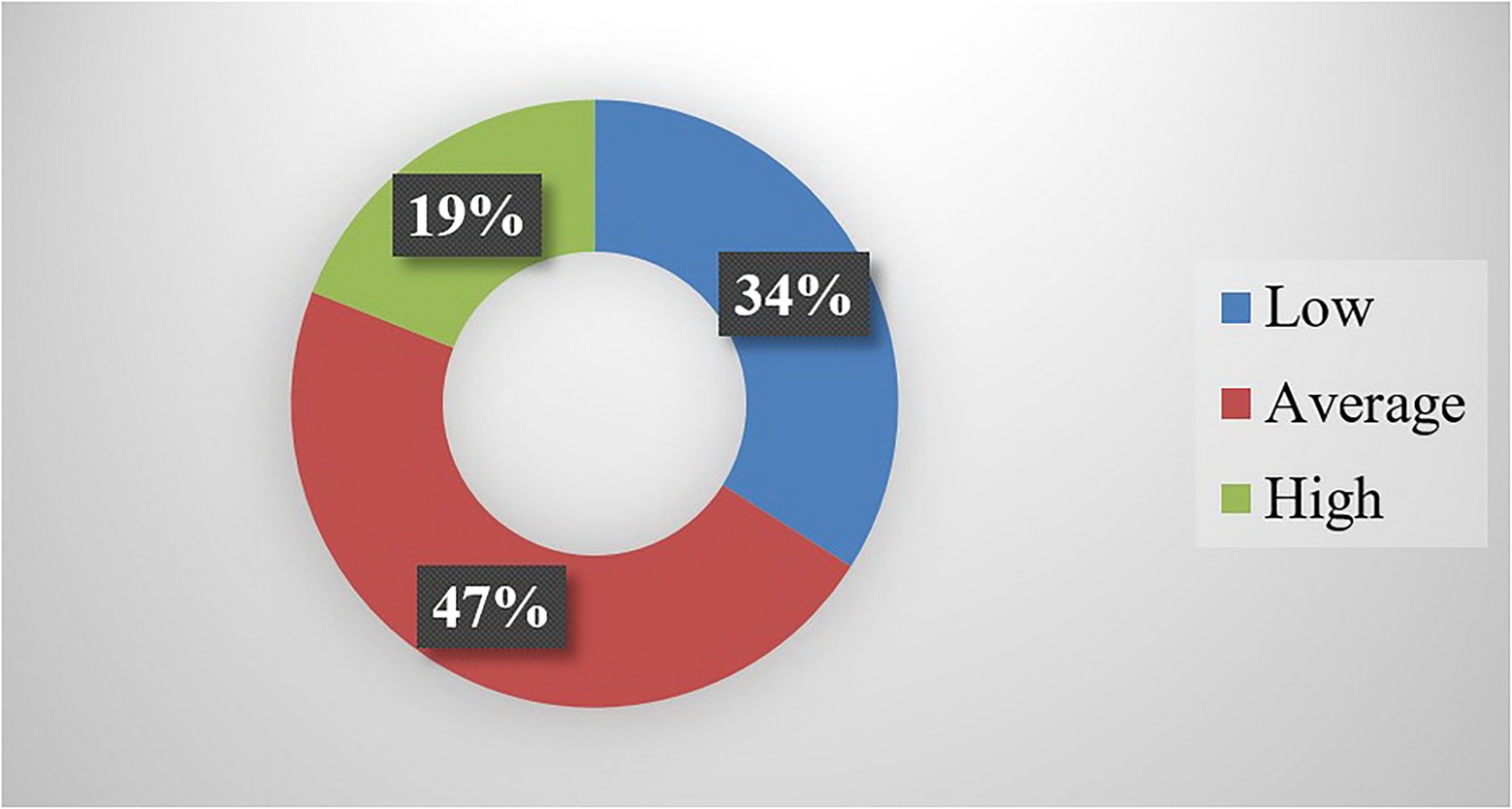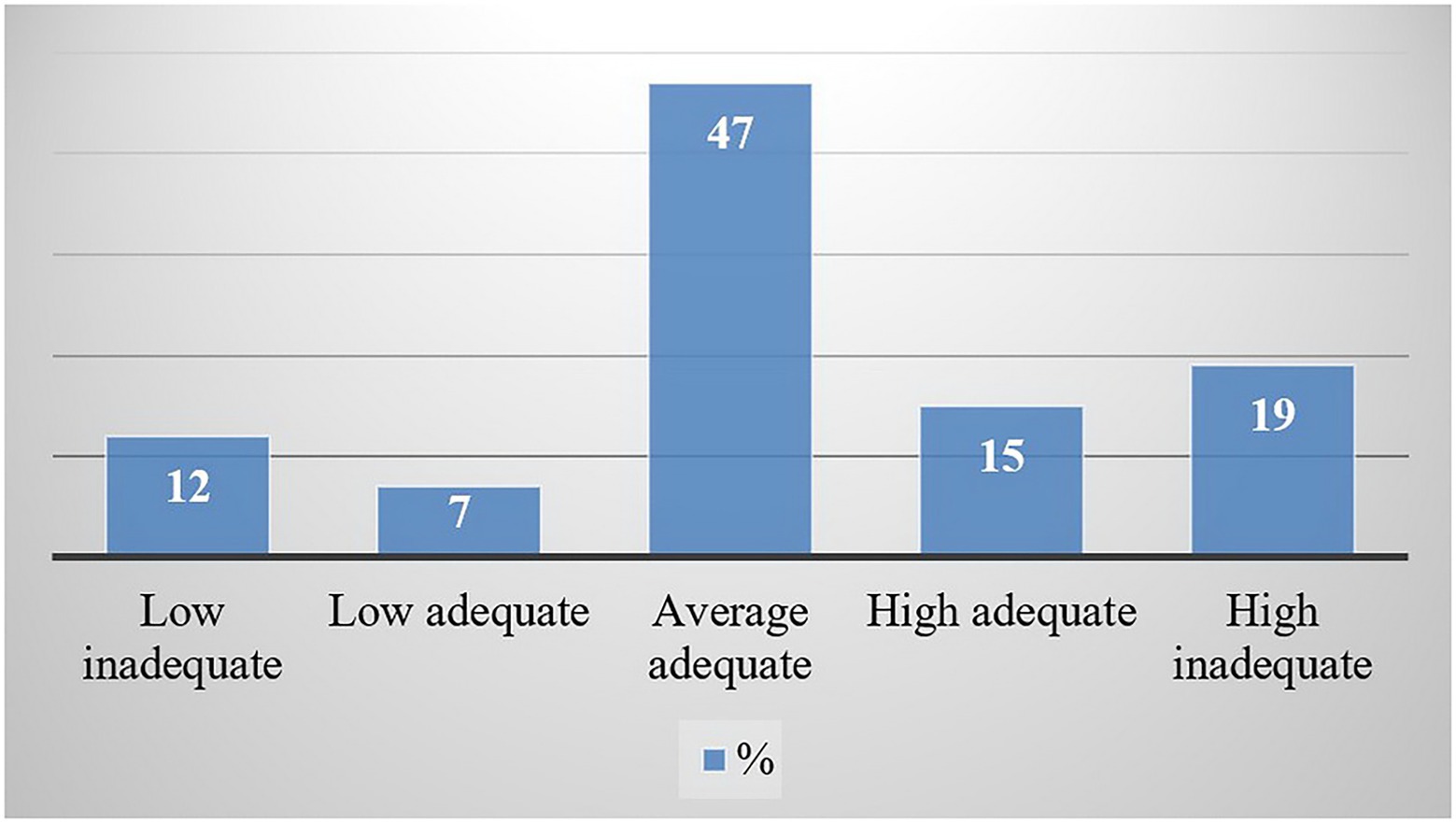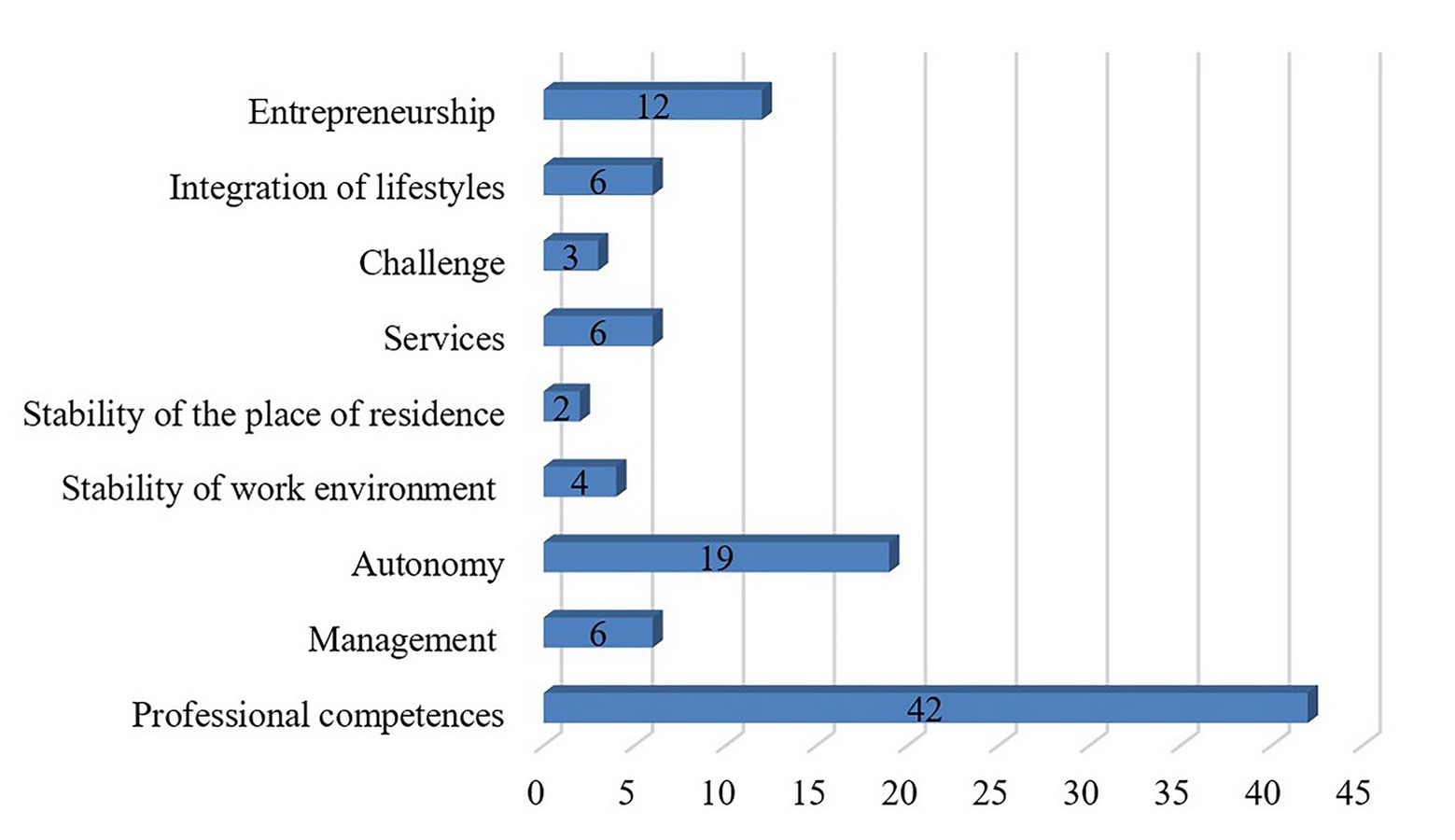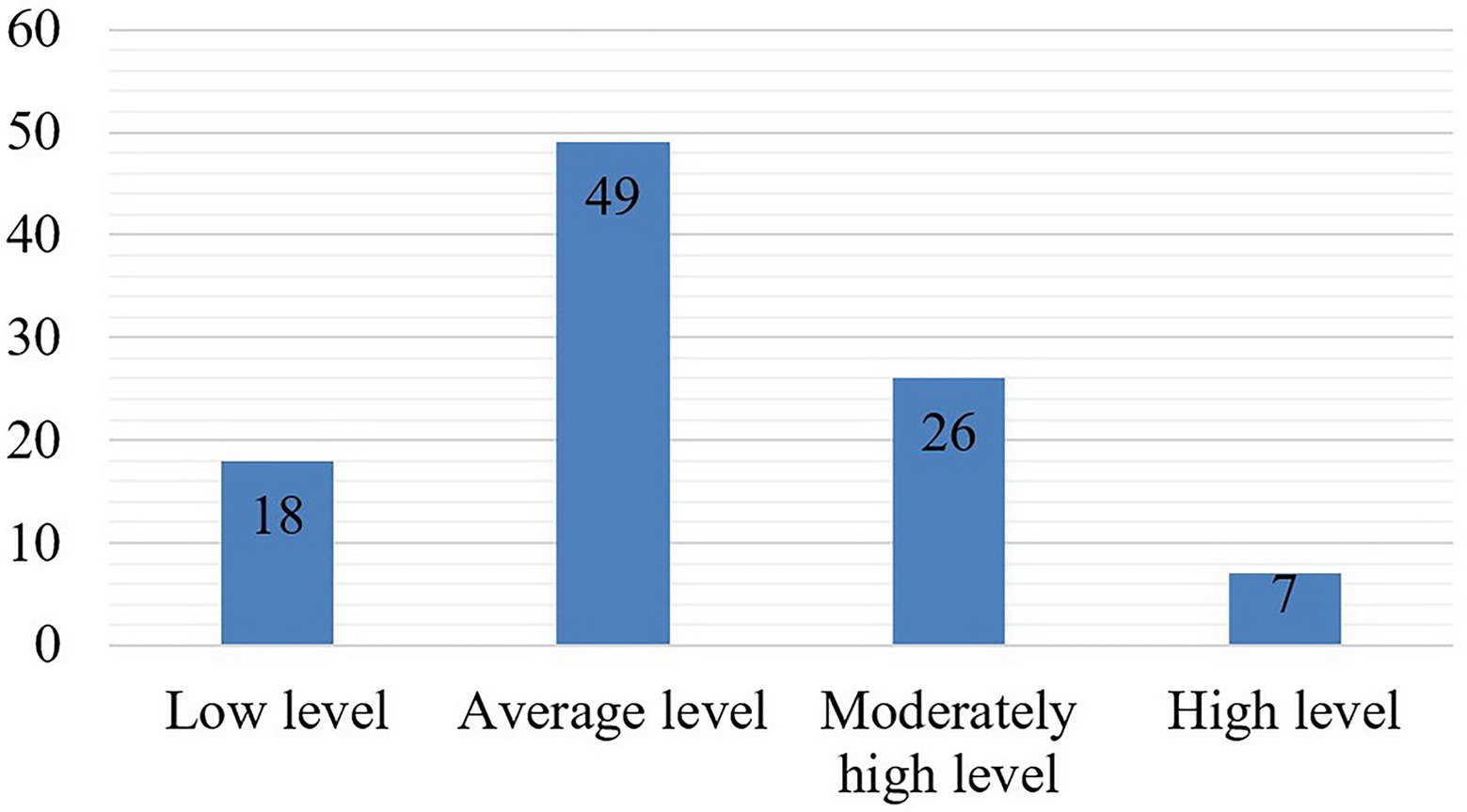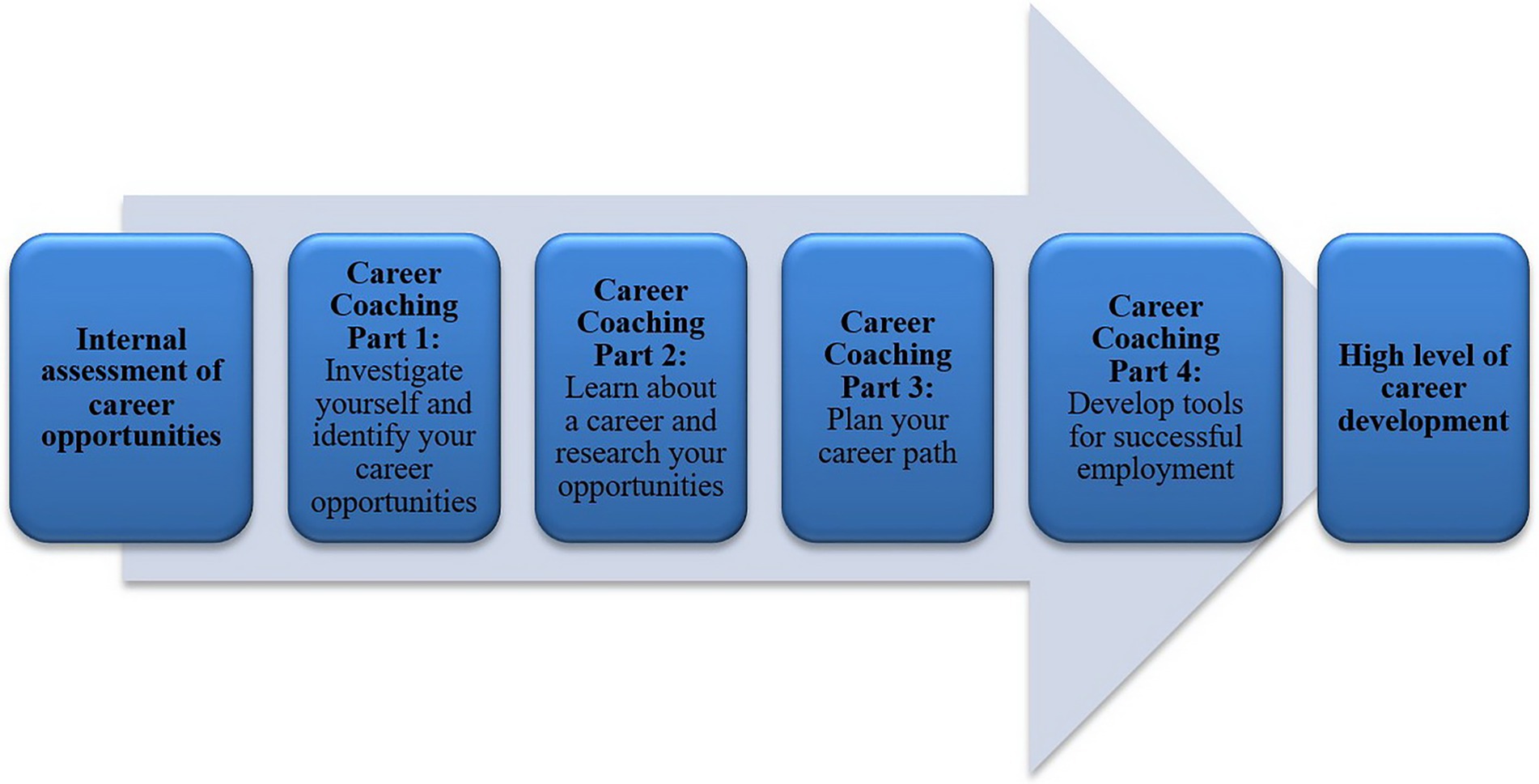- 1Department of Personal Development and Education, NJSC Toraighyrov University, Pavlodar, Kazakhstan
- 2Department of Trilingualism, NJSC Toraighyrov University, Pavlodar, Kazakhstan
- 3Department of Foreign Languages, Plekhanov Russian University of Economics, Moscow, Russia
Effective implementation and development of the career development programmes determine the economic growth of countries. The research aims to discuss and analyze the characteristics and elements of the students’ career opportunities. The results help the scholars select the proper type of analysis and appropriate tools to examine the elements of career opportunities. The sample consisted of 102 third and fourth year students from NJSC Toraighyrov University. The following methods and criteria were used to analyze the initial stage of the student career development: emotional intelligence (based on the methodology proposed by J. N. Hall), communication skills (Test of communication skills by L. Mikhelson), self-assessment (S. A. Budassi’s method of self-assessment), career value orientations (Edgar Schein’s Career Anchors), motivation for success (The Questionnaire by T. Ehlers). The surveys were conducted using Google Forms. The results helped to identify the characteristics and elements of the students’ career opportunities. The data collected at NJSC Toraighyrov University of the Republic of Kazakhstan show that 35% of students have a low level of emotional intelligence, 47% have addictive behaviors during communication, 31% of respondents have low self-esteem, lack of motivation for success was identified in 18% of students. Only a small number of students could clearly define their career orientations regarding Lifestyle Integration, Challenge and Management. The research suggests that it is important to introduce career development programmes that empower students and encourage them to build professional career paths in the future. Used as a learning framework, the Career coaching programme helps to design, develop, assess and implement each element of the career opportunities. The implementation advantages of the Career coaching programme for students as part of the educational process are discussed in the present research. The programme Career coaching will develop awareness and advance careers among graduate students. Moreover, it will provide a guideline for the first steps toward developing a successful career path.
Introduction
High-quality preparation of students and pursuing a career path that interests them is one of the ways for countries to ensure stable economic growth (Boat et al., 2021). The fast development of civilization becomes an obstacle for many students to fulfill their career opportunities and build a successful career (Van der Horst et al., 2021). From year to year, employment requirements for employees are increasing, and some professions are becoming obsolete and even unnecessary. Medium and small businesses are developing, and new requirements for job seekers are changing dramatically (Emanuel et al., 2021).
In addition to professional knowledge, skills and abilities, a graduate must have self-esteem, a desire to continue learning and take advanced training even if they complete formal education and enter the workforce. Moreover, graduates should have the good critical thinking, developed communication skills, high emotional intelligence, the ability to solve various kinds of problems and use modern technologies in the learning process (Gordieiev et al., 2014).
The concept of Career Opportunities is at the initial stage of its development, so the scholars combine two concepts as Career and Personal opportunities into one.
The present research proposes different definitions of a career term. The research analyses scientific sources that examine the career concept, its developments and opportunities for its implementation. Therefore, the concept of career means a process of career development and actions undertaken by an employee to ensure professional progress and advances during the working life (Kleine et al., 2021).
Personal opportunities and the ability to work are important factors for career development. Motivation at work influences the process of building a career. Career development depends upon the ability to work and facilitate overall success in the profession. The opportunities of an employee should not be limited by psychological, physical and pedagogical factors, inclinations, acquired experience and knowledge. They are subjected to life experience, professional skills and overall knowledge about the world (Kuehn, 2008).
The concept of career opportunities includes two important notions: personality and intellect (Leutner and Chamorro-Premuzic, 2018). Career opportunities mean a set of internal resources of the individual and management of these resources. Moreover, career opportunities depend greatly upon the overall success of career building, intelligence viewed as a fundamental component, and the academic performance of each student that is not assessed by employers (Ganiyeva and Pfeifer, 2020).
Career success largely depends on the personal opportunities, skills, professional orientations, motivations, needs and values of young employees. The current research reflects the development of certain aspects of career opportunities, including career orientations as the important incentives for work productivity and output (Schein, 1996); emotional intelligence, perceived as the ability to identify and manage emotions (Urquijo et al., 2019); motivation as a factor of progressive career development (Day and Allen, 2004); self-esteem, as a person’s ideas about himself and his qualities (Yang and Wong, 2020) and communication skills, as the ability to communicate effectively (Pico-Saltos et al., 2021).
The literature analysis identified elements of career opportunities in students. The research was conducted using a sample of third and fourth year students from NJSC Toraighyrov University, analyzing the following issues:
- emotional intelligence;
- motivation for success;
- self-assessment;
- communication skills;
- value orientations.
A high level of emotional intelligence has a positive impact on mental health, work competencies and leadership skills (Goleman, 1995). The ability to identify and manage emotions, as well as the emotions of other individuals, directly affects the labor productivity and profitability of an organization (Santos et al., 2018). Therefore, HR managers, employers and recruiters are looking for employees who are good team members, understand colleagues, demonstrate high productivity and quality of work, and want to move up the company ladder (Sidebotham et al., 2020). It is important to foster emotional intelligence in students. In the final years of education, graduates will be able to analyze the difficult situation, introduce changes and communicate with other employees at the workplace (Akhtar et al., 2015).
Any activity of an individual, including professional life, begins with an impulse to act, or in other words, with motivation to work (Burk and Wiese, 2018). Career motivation differs among individuals. It is important to identify motivation in the final university years. A student, a future employee motivated for success, should be aware of career needs considered the most critical factors influencing organizational performance (Copuš et al., 2019).
In the career development of the individual, self-esteem plays a pivotal role, reflecting confidence in personal and professional strengths (Modestino et al., 2019). Success is always a result of an internal rather than an external stimulus. Self-esteem, an internal resource of career opportunities, is the driving force behind all types of personality development (Karababa, 2020). It is very important for a student to develop effective communication with peers, earn the respect of faculty members and build the trust of the university administration. It is difficult for a student with low or overestimated self-esteem to interact with other members of the educational community because he cannot interpret the world and make the right decisions (Wang et al., 2021).
Moreover, at the initial stages of career building, it is very important for an applicant to demonstrate confidence and attract the attention of employers for successful employment and rapid career advancement (Takeuchi et al., 2021).
Business communication skills, the ability to think creatively and adapt to a certain communication style in the business environment are important elements of professional training (Karoly, 2008). The age of Information Workers means a workplace with employees who possess verbal, informational, technical and visual literacy (Seitenov et al., 2020). Therefore, it is crucial to develop cognitive skills in students such as critical thinking, communication skills, the ability to make correct and on-time decisions, and build teamwork skills. Organizations should use modern methodological approaches and pedagogical innovations to develop the professional skills and competencies of students (Zarudnaya et al., 2018). Many employers introduce training for employees on business communications using psychological training, business games, role-playing games with dramatization, group discussions, advanced training techniques, etc. However, the development of communicative literacy in university students will ensure their competitiveness in the current labor market.
Each employee chooses a way of life and a career path that meets his values and worldviews (Hirschi and Koen, 2021). If the student works within an organization that shares the same values, he will be able to develop a successful career. The analysis of values and career expectations of university students will help to develop career opportunities and choose the right career path (Cortellazzo et al., 2020).
The research aims to discuss and analyze the characteristics and elements of the students’ career opportunities. The research includes the following stages to achieve this goal: determining the main elements of the career opportunities, conducting the analysis, identifying the forms and methods for developing the career opportunities.
Materials and methods
Sampling
The sample included 302 third and fourth year students (the number of students from each course is 50%) from NJSC Toraighyrov University (Pavlodar, the Republic of Kazakhstan).
The research purpose is to analyze the characteristics and elements of the students’ career opportunities. The gender, year of study and specialities are available in Table 1. The research involved third and fourth-year students, from 19 to 22 years. In the final years of education, students can establish new contacts, be involved in new communication patterns and demonstrate social behavior. In the research, gender differences and academic specialities were not taken into account. The general level of the career opportunities in students to develop the framework was identified.
Research design
The following methods were used to analyze elements of career opportunities among university students (Table 2). For the analysis of emotional intelligence, the methodology proposed by J. N. Hall was used. The test identifies the ability to define emotions, the ability to control an emotional sphere through choice and decision-making. The test has five scales and consists of 30 points (Ramanauskas, 2016). Test of communication skills by L. Mikhelson was used for the determination of the level of communication skills. To identify a quantifiable level of self-evaluation S. A. Budassi’s method of self-esteem was used. Career value orientations were determined based on Edgar Schein’s Career Anchors methodology. The methodology defines motives for a career choice, the values of an individual and his understanding of career and professional performance (Abessolo et al., 2017). Motivation for success was analyzed with the help of the Questionnaire by T. Ehlers. The test determines motivation to achieve individual success across the lifespan.
Survey
Students of NJSC Toraighyrov University performed five tests to identify the initial level of career opportunities. All research stages were carried out online because of the complicated epidemiological situation and the Covid-19 pandemic restrictions. During the Covid-19 pandemic, NJSC Toraighyrov University has provided remote education, so all students were equipped with necessary technological and Internet resources (laptops and wireless routers for the Internet). The university administration gave consent to collect data for the research. The conference on the zoom platform was held by one of the researchers to familiarize students with the research process. Students were well aware of Zoom and its functions before the research. During the conference, all students confirmed their consent to participate in the research. They were provided with full instructions on each of the proposed methods (tests). Students may ask any questions unclear or ambiguous to them.
The test questions were in Google forms. The questionnaire consisted on the questions from the Test by J. N. Hall, Test of communication skills by L. Mikhelson, Test by S. A. Budassi, Edgar Schein’s Career Anchors Test, Questionnaire by T. Ehlers. Links to online surveys were sent by e-mail to all participants. The survey took up to 2 months because students had to answer many test questions and took time to respond to all tasks. On the first month, the tests collected information on the level of emotional intelligence and the development of communication skills. The analysis of self-esteem, motivation for success and value orientations in a career were carried out on the second month. All tests have been assessed to ensure quality and availability. Each student independently answered the numbered questions, provided to them during the online meeting. The results were recorded in a Google spreadsheet for further analysis, and it made it possible to use descriptive statistics and present the data as a graphic chart.
Research limitations
The research limitations include limited sample size and the data collected in one educational institution. The research includes the initial analysis of the elements of the career opportunities and does not cover the dynamics of its development. Further research on these issues is required.
Ethical issues
The students participated voluntarily in the research. The scholars ensured the anonymity of the results. The online surveys did not include questions on any personal identification and personal data of the respondents.
Results
The results demonstrate the main elements of the career opportunities, which was determined by the purpose of the study. The results of all tests are correlated in such a way that each test is aimed at determining the main elements of the career opportunities (one test - one element of career opportunities). All these tests, which apply to each defined element of career opportunities, are aimed at achieving the goal of the study.
The analysis of emotional intelligence (Figure 1) shows that the majority of students has an average level of emotional intelligence (43%), 35% of students have a low level of emotional intelligence, and only 22% of students have a high level. These indicators indicate the need to increase the level of emotional intelligence of students as one of the elements of career opportunities, which can increase the probability of a positive result when students are looking for a job.
The results (Figure 2) show that most students received an average level on all tests except the test on Manage your emotions (24%). The research found that students acquired the necessary skills to manage emotions. About 42% of the respondents noted that they experiences difficulties managing emotions, they could not control and sustain in different life situations. The emotional awareness (knowledge of emotions and emotional states) among students was as follows: an average level – 61%, high level – 20%, low level – 19%. The inability or low level of development of the skills of managing emotions by students reduces not only the probability of getting a job, but also complicates communication in the team of employees (at work) and students (at university). A possible solution to this problem is the organization and conduct of psychological trainings and workshops with the involvement of professional psychologists in order to teach students to control their emotions. Self-motivation (emotional mood) was identified in 63% of students, a high rate of self-motivation is demonstrated by 13% and a low rate by 24% of the students.
The average level of empathy was reported by half of the respondents (53%). The ability to understand the feelings and emotions of other individuals, without experiencing any difficulties, was reported by 18% of students. Less than one-third of students (29%) had a low level of empathy.
The test on controlling the emotions of other people showed that only 10% of students had a high level, 54% had an average level and 36% had a low level of control. Most students needed to develop the ability to evoke powerful emotional responses in other people and reduce negative emotions.
The analysis and results of communication skills among students are presented in Figure 3. The research identified that only 19% of students demonstrated aggressive communication patterns. The majority of students, being in their teens and studying at school, have passed the stage of risk-taking and disobedience. At the university, students demonstrate positive communication skills. About one-third of students (34%) had well-developed communication patterns and interacted with their peers. Figure 3 shows that the main communication pattern is an addictive one (47%). The students exhibit addictive behavior interacting with peers or adults they respect. A high level of development of communication skills among students increases the chances of finding career opportunities, in particular, improves communication between employees and thus improves the quality of work.
The results of self-esteem (Figure 4) reveal that most students have an adequate average level of self-esteem (47%). Most students show a positive attitude toward themselves. They demonstrate an understanding of strengths and weaknesses, a willingness to analyze situations and choose the best solution to achieve goals. A slight difference is identified among students with high self-esteem. Moreover, 15% of students have adequate high self-esteem and 19% have inadequate high self-esteem. Students with adequate high self-esteem show flexible thinking but painlessly perceive criticism. On the contrary, students with inadequate high self-esteem believe that their actions cannot be criticized. Thus, they often accept wrong decisions due to weak critical thinking skills. Inadequate low self-esteem has 12% of the respondents who cannot fully accept themselves. Most often, such students have lower goals than others. Only 7% of students show adequate low self-esteem. These students accept only positive personal qualities, paying no attention to negative ones. It causes rejection of their personality and misunderstanding of individuals around them.
The data (Figure 5) show that the majority of students (42%) accept Professional Competence as the leading career strategy. It supports the need to acquire professional knowledge, skills for a certain type of activity and the desire to succeed in life.
The issue of Autonomy is important for 19% of students. They do not follow rules and regulations, but act independently and decide everything on their own. The next issue highlighted by 12% of the students was Entrepreneurship. The students underline that they are ready to take risks, want to start their business, be financially independent and not be employed with other companies. NJSC Toraighyrov University prepares students for entrepreneurial activities, so students receive knowledge and skills to start their business in the future. The tests on Integration of lifestyles, Service and Management show the same percentage in each category (6%). One of the issues related to career orientation, Stability of work environment, got 4%. It means that these students are interested in work mobility and changing organizational environments. Another issue analyzed by the research was Challenge. Only 3% of the students wanted to overcome obstacles, solve complex problems, ensure competence, and compete over others. For 2% of the respondents, the Stability of the place of residence was important. The majority of students are ready to relocate and change their place of residence to develop a successful career.
Figure 6 shows the results on motivation levels in achieving success. Among the respondents, most students (49%) have the average level of motivation to achieve career success. The majority of students do not differentiate success or failure at work. Some students should be motivated to develop a career path. About a quarter of students (26%) had a moderately high level of motivation to achieve career success. These students admitted a strong desire to succeed. They were active and persistent in learning. Only 7% of the students showed a high level of motivation to develop a successful career path.
The obtained indicators testify to the predominance of the average level of motivation of students to achieve career success, which makes it possible to conclude that it is necessary to increase the motivation of students at the expense of conducting various activities for career development and growth, demonstrating various professions and showing opportunities for achieving career success in each of them. Career orientation events, etc.
Most students are motivated for success and focus on achieving career goals. The research showed that only 18% of students had low motivation for success. The main emotions of such students were self-doubt and fear of failure. It affected the assimilation of knowledge that could lead to a negative attitude of the management team in the future.
Using the results, the framework of Career coaching was developed and implemented at the university (Figure 7). The results presented above demonstrated the initial level of the career opportunities for students of the third and fourth years of study. It was considered the starting point in developing the career opportunities of students.
The first part of the Career Coaching aims to develop the career opportunities identified by the research: emotional intelligence, self-esteem, communication skills, motivation for success and career value orientations. The students examine self-opportunities and self-potential. The second section develops student knowledge about the concepts, types and varieties of careers, the main elements of a career path, and the criteria of its success. Learning the Career Coaching programme students get acquainted with the options for career advancement, methods of planning and career development. The third section of the programme helps students in their final years at the university to develop their career plans.
A well-thought plan where to start a career, rather than where to end it, is a way to choose between alternatives available to every individual. The fourth section helps students to develop tools for effective employment that will help them sell their resume to a potential employer. Students should know how to interact with a future employer, present their candidacy, write a resume, highlight advantages in social networks, and pass interviews.
In the future, there is a need to develop a full programme, based on the framework, and introduce it to the educational process. Moreover, the research will analyze the results and conduct a comparative analysis of the present research and the future one.
Discussion
Career development is an ongoing process consisting of learning about individuals and the environment. Career growth is influenced by individual changes, career values, and goal setting (Nagy et al., 2019). Similar to our study the research underlines that it is necessary to develop a desire for career development throughout the university years.
The opportunities and personal characteristics of an individual are the keys to success in any activity, including career development (Hirschi et al., 2021). The concept of personal opportunities in one of the researches coincides with the theoretical background of the present research. It defines the opportunities of the individual as a complex concept. Its characteristics are reflected in a wide range of situations and determine the consequences (Romanova et al., 2020). It is important to assist students in the implementation and development of their career opportunities.
The research conducted in the Netherlands was based on a sample of 704 young professionals between 21 and 35 years. The results showed that a modern employee with professional qualities has good employment opportunities (Blokker et al., 2019). Professional competence is important for employment and building a successful career for young professionals, as well as the ability to identify factors of career opportunities for students within their area of study.
Career centers should be an integral part of education around the world. According to the survey results of students studying in the second, third, fourth years and graduates of the University of Michigan, 76.8% of respondents are satisfied with career development services (Ives et al., 2020). Career centers help graduates cope with planning issues, build a career and respond effectively to economic or environmental factors (Dey and Cruzvergara, 2014). Similar to our study the researchers agree that it is becoming increasingly difficult to manage career development and manage the modern workforce.
University career services are staffed by qualified specialists who help students make career decisions and achieve goals. They focus on prospects for further employment of graduates (Healy et al., 2020) and work with a large number of students. Similar to our study the research admits that career centers are overloaded with service requests and enquiries from people seeking advice.
Career adaptation may lead to psychological manifestations such as mania, envy, manic or true reparation, measured using the Dynamic Career Line (DCL; Caputo et al., 2020). Therefore, the tools and methods of influence on career adaptation are diverse and may change over time.
The research of 433 undergraduates from the US and Australia, conducted at two universities, finds that university administration pays little attention to career services for students. Universities do not help students develop their career paths and build a career (Jackson and Tomlinson, 2019). Similar to our study the results show that there is a need to develop career services within the curriculum to help students understand what is important to them and develop the career ladder.
Psychological issues play a crucial role in the development of career opportunities among students. Career Development Applications are designed to foster change and help students in career development. The emphasis is on the development of positive emotions of the individual to ensure the personal well-being of employees and the organization (Dik et al., 2014). Similar to our study the authors think that in order to form positive emotions, it is important to develop emotional intelligence and the components of individual career opportunities.
At Marmara University, the administration introduced the career development programme that helped students gain experience and mastered the qualifications necessary for career building. Surveys were conducted before and after the programme. The findings show an increased awareness among students, as well as confidence in career building (Aydın et al., 2016).
The human resource specialists should take into account the family history and a place of residence assessing career opportunities for students. The family business, family-based crafts, migration and the current place of residence of the individual can affect the employment (Mitrovic Veljkovic et al., 2019). These issues were beyond the scope of the present research. In the future, these characteristics should be considered and investigated to improve the research accuracy.
Students in final years of education are focused on preparing for the final exams, rather than on career planning. They do not focus on employment and the first steps toward building a successful career (Kinash et al., 2017). Students should be motivated to plan their careers and think about employment opportunities. Career development programmes should function in parallel with preparation for exams. It will have a positive impact on the results of further career development (Hansen et al., 2016).
Many modern organizations have examined new ways to create jobs and expand career opportunities for employees (Mulhall, 2014). The introduction of career development programmes at universities will anticipate this process. It is necessary to launch career coaching programmes, help students develop career skills and take the first steps toward building a successful career path (Bear, 2016).
Career opportunities are a complex phenomenon that combines resources of various kinds. The final years at the university are decisive for students. They determine success in future employment and building a career path. Some students are concerned about their future careers, but some individuals are indifferent towards their careers. However, most students will get a job after graduation and enter the workforce (Gunawan et al., 2019).
Conclusion
The research examined the individual career resources and career opportunities available for the final year students. The need to explore these issues was caused by the lack of research in this field and the ineffectiveness of future professional activities among students. In the final years of education, students need to make decisions about their further career development, ask questions about a particular type of profession and where to start their career. The problem of career opportunities and professional paths are crucial for third and fourth years students. The results prove that a modern graduate is limited in resources and career achievements. Many students are not able to compete with the high-qualified workforce. In this regard, students may experience difficulties integrating into the professional community.
The data collected at NJSC Toraighyrov University of the Republic of Kazakhstan show that 35% of students have a low level of emotional intelligence, 47% have addictive behaviors during communication, 31% of respondents have low self-esteem, lack of motivation for success was identified in 18% of students. Only a small number of students could clearly define their career orientations regarding Lifestyle Integration, Challenge and Management.
The results of the research can be used to find new ways to expand the career opportunities of students of various specialties and various educational courses. In addition, the obtained indicators can be useful in the development of methods of increasing the motivation of students in achieving success. Further research is needed to investigate the development of career opportunities after the application of the proposed career programme and compare it with the initial career opportunities. The career success of each student and a team member influences labor productivity within the organization. The research highlights the need to assess work opportunities in the final years at the university. A graduate with an understanding of career opportunities and a career path will become a successful professional in the future and a valued employee of any organization.
Data availability statement
The original contributions presented in the study are included in the article/supplementary material, further inquiries can be directed to the corresponding author.
Ethics statement
The studies involving human participants were reviewed and approved by the NJSC Toraighyrov University. The ethics committee waived the requirement of written informed consent for participation.
Author contributions
NP and EP performed the data collection, material preparation, and analysis. MU and AB wrote the first draft of the manuscript. All authors contributed to the study conception and design, read, and approved the final manuscript.
Conflict of interest
The authors declare that the research was conducted in the absence of any commercial or financial relationships that could be construed as a potential conflict of interest.
Publisher’s note
All claims expressed in this article are solely those of the authors and do not necessarily represent those of their affiliated organizations, or those of the publisher, the editors and the reviewers. Any product that may be evaluated in this article, or claim that may be made by its manufacturer, is not guaranteed or endorsed by the publisher.
References
Abessolo, M., Rossier, J., and Hirschi, A. (2017). Basic values, career orientations, and career anchors: empirical investigation of relationships. Front. Psychol. 8:1556. doi: 10.3389/fpsyg.2017.01556
Akhtar, R., Boustani, L., Tsivrikos, D., and Chamorro-Premuzic, T. (2015). The engageable personality: personality and trait EI as predictors of work engagement. Pers. Individ. Diff. 73, 44–49. doi: 10.1016/j.paid.2014.08.040
Aydın, S., Yurtsever, B., Tok, S., and Sönmez, D. (2016). A Study of Career Orientations of Marmara University Department of Political Science Students. Istanbul: Marmara University.
Bear, S. E. (2016). A new career strategies course for undergraduate business students. Bus. Educ. Innov. J. 8, 79–84.
Blokker, R., Akkermans, J., Tims, M., Jansen, P., and Khapova, S. (2019). Building a sustainable start: the role of career competencies, career success, and career shocks in young professionals’ employability. J. Vocat. Behav. 112, 172–184. doi: 10.1016/j.jvb.2019.02.013
Boat, A. A., Syvertsen, A. K., and Scales, P. C. (2021). The role of social capital in promoting work readiness among opportunity youth. Child Youth Serv. Rev. 131:106270. doi: 10.1016/j.childyouth.2021.106270
Burk, C. L., and Wiese, B. S. (2018). Professor or manager? A model of motivational orientations applied to preferred career paths. J. Res. Pers. 75, 113–132. doi: 10.1016/j.jrp.2018.06.002
Caputo, A., Fregonese, C., and Langher, V. (2020). Development and validation of the dynamic career scale (DCS): a psychodynamic conceptualization of career adjustment. Int. J. Educ. Vocat. Guid. 20, 263–292. doi: 10.1007/s10775-019-09403-5
Copuš, L., Šajgalíková, H., and Wojčák, E. (2019). Organizational culture and its motivational potential in manufacturing industry: subculture perspective. Procedia Manuf. 32, 360–367. doi: 10.1016/j.promfg.2019.02.226
Cortellazzo, L., Bonesso, S., Gerli, F., and Batista-Foguet, J. M. (2020). Protean career orientation: behavioral antecedents and employability outcomes. J. Vocat. Behav. 116:103343. doi: 10.1016/j.jvb.2019.103343
Day, R., and Allen, T. D. (2004). The relationship between career motivation and self-efficacy with protégé career success. J. Vocat. Behav. 64, 72–91. doi: 10.1016/s0001-8791(03)00036-8
Dey, F., and Cruzvergara, C. Y. (2014). Evolution of career services in higher education. New Dir. Stud. Serv. 2014, 5–18. doi: 10.1002/ss.20105
Dik, B. J., Duffy, R. D., Allan, B. A., O’Donnell, M. B., Shim, Y., and Steger, M. F. (2014). Purpose and meaning in career development applications. Couns. Psychol. 43, 558–585. doi: 10.1177/0011000014546872
Emanuel, F., Ricchiardi, P., Sanseverino, D., and Ghislieri, C. (2021). Make soft skills stronger? An online enhancement platform for higher education. Int. J. Educ. Res. Open 2:100096. doi: 10.1016/j.ijedro.2021.100096
Ganiyeva, E. S., and Pfeifer, N. E. (2020). Structure and content of students’ career potential. Bulletin of PSU by S Toraighyrov. Pedagog. Ser. 2, 136–142.
Gordieiev, O., Kharchenko, V., Fominykh, N., and Sklyar, V. (2014). Evolution of software quality models in context of the standard ISO 25010. Adv. Intell. Syst. Comput. 286, 223–232. doi: 10.1007/978-3-319-07013-1_21
Gunawan, W., Creed, P. A., and Glendon, A. I. (2019). Development and initial validation of a perceived future employability scale for young adults. J. Career Assess. 27, 610–627. doi: 10.1177/1069072718788645
Hansen, J. M., Jackson, A. P., and Pedersen, T. R. (2016). Career development courses and educational outcomes. J. Career Dev. 44, 209–223. doi: 10.1177/0894845316644984
Healy, M., Hammer, S., and McIlveen, P. (2020). Mapping graduate employability and career development in higher education research: a citation network analysis. Stud. High. Educ. 47, 799–811. doi: 10.1080/03075079.2020.1804851
Hirschi, A., Johnston, C. S., De Fruyt, F., Ghetta, A., and Orth, U. (2021). Does success change people? Examining objective career success as a precursor for personality development. J. Vocat. Behav. 127:103582. doi: 10.1016/j.jvb.2021.103582
Hirschi, A., and Koen, J. (2021). Contemporary career orientations and career self-management: a review and integration. J. Vocat. Behav. 126:103505. doi: 10.1016/j.jvb.2020.103505
Ives, R. C., Klein, K. C., and Mason, N. A. (2020). Career and professional development services for pharmacy students. Curr. Pharm. Teach. Learn. 12, 1110–1115. doi: 10.1016/j.cptl.2020.04.026
Jackson, D., and Tomlinson, M. (2019). Career values and proactive career behaviour among contemporary higher education students. J. Educ. Work. 32, 449–464. doi: 10.1080/13639080.2019.1679730
Karababa, A. (2020). The reciprocal relationships between school engagement and self-esteem among Turkish early adolescents: a three-wave cross-lagged model. Child Youth Serv. Rev. 116:105114. doi: 10.1016/j.childyouth.2020.105114
Karoly, L. (2008). The 21st Century at Work: Forces Shaping the Future Workforce and Workplace in the United States. Santa Monica, CA: RAND Corporation.
Kinash, S., Crane, L., Capper, J., Young, M., and Stark, A. (2017). When do university students and graduates know what careers they want: a research-derived framework. J. Teach. Learn. Grad. Employab. 8, 3–21. doi: 10.21153/jtlge2017vol8no1art584
Kleine, A.-K., Schmitt, A., and Wisse, B. (2021). Students' career exploration: a meta-analysis. J. Vocat. Behav. 131:103645. doi: 10.1016/j.jvb.2021.103645
Leutner, F., and Chamorro-Premuzic, T. (2018). Stronger together: personality, intelligence and the assessment of career potential. J. Intelligence 6:4. doi: 10.3390/jintelligence6040049
Mitrovic Veljkovic, S., Maric, M., Subotic, M., Dudic, B., and Greguš, M. (2019). Family entrepreneurship and personal career preferences as the factors of differences in the development of entrepreneurial potential of students. Sustainability 11:20. doi: 10.3390/su11205693
Modestino, A. S., Sugiyama, K., and Ladge, J. (2019). Careers in construction: an examination of the career narratives of young professionals and their emerging career self-concepts. J. Vocat. Behav. 115:103306. doi: 10.1016/j.jvb.2019.05.003
Mulhall, S. (2014). “Careers and Career Development,” in Strategic HRM: Research and Practice in Ireland. eds. B. Harney and K. Monks (Dublin: Orpen Press), 211–229.
Nagy, N., Froidevaux, A., and Hirschi, A. (2019). “Lifespan perspectives on careers and career development” in Work Across the Lifespan. eds. B. B. Baltes, C. W. Rudolph, and H. Zacher (Cambridge, MA: Elsevier Academic Press), 235–259.
Pico-Saltos, R., Carrión-Mero, P., MontalvánBurbano, N., Garzás, J., and Redchuk, A. (2021). Research trends in career success: a bibliometric review. Sustainability 13:4625. doi: 10.3390/su13094625
Ramanauskas, K. (2016). The impact of the manager's emotional intelligence on organisational performance. Vadybos mokslas ir studijos-kaimo verslų ir jų infrastruktūros plėtrai 38, 58–69. doi: 10.15544/mts.2016.6
Romanova, E. S., Bershedova, L. I., Tolstikova, S. N., Rychikhina, E. N., and Morozova, T. Y. (2020). Fulfilment of personal potential by high school graduates in time of career choice. Cypriot J. Educ. Sci. 15, 423–432. doi: 10.18844/cjes.v%vi%i.4908
Santos, A., Wang, W., and Lewis, J. (2018). Emotional intelligence and career decision-making difficulties: the mediating role of career decision self-efficacy. J. Vocat. Behav. 107, 295–309. doi: 10.1016/j.jvb.2018.05.008
Schein, E. H. (1996). Career anchors revisited: implications for career development in the 21st century. Acad. Manag. Perspect. 10, 80–88. doi: 10.5465/ame.1996.3145321
Seitenov, A. S., Aubakirova, R. Z., Fominykh, N. I., and Вelenko, O. G. (2020). Technological dimension of pre-school teacher training at tertiary school: fine arts concept-based case study. J. Soc. Stud. Educ. 11, 186–203.
Sidebotham, M., Walters, C., Baird, K., and Gamble, J. (2020). Simulated employment interviews: a collaborative approach to gaining understanding of the graduate midwife employment process. Women Birth 33, 455–463. doi: 10.1016/j.wombi.2019.10.005
Takeuchi, N., Takeuchi, T., and Jung, Y. (2021). Making a successful transition to work: a fresh look at organizational support for young newcomers from an individual-driven career adjustment perspective. J. Vocat. Behav. 128:103587. doi: 10.1016/j.jvb.2021.103587
Urquijo, I., Extremera, N., and Azanza, G. (2019). The contribution of emotional intelligence to career success: beyond personality traits. Int. J. Environ. Res. 16:23. doi: 10.3390/ijerph16234809
Van der Horst, A. C., Klehe, U.-C., Brenninkmeijer, V., and Coolen, A. C. M. (2021). Facilitating a successful school-to-work transition: comparing compact career-adaptation interventions. J. Vocat. Behav. 128:103581. doi: 10.1016/j.jvb.2021.103581
Wang, Y., Huebner, E. S., and Tian, L. (2021). Parent-child cohesion, self-esteem, and academic achievement: the longitudinal relations among elementary school students. Learn. Instr. 73:101467. doi: 10.1016/j.learninstruc.2021.101467
Yang, L., and Wong, L. P. (2020). Career and life planning education: extending the self-concept theory and its multidimensional model to assess career-related self-concept of students with diverse abilities. ECNU Rev. Educ. 3, 659–677. doi: 10.1177/2096531120930956
Keywords: building a successful career path, career, career development, career opportunities, career success
Citation: Pshembayeva E, Pfeyfer N, Uaikhanova M and Bubenchikova A (2022) Career success: Analysis and development of career opportunities in students. Front. Educ. 7:999541. doi: 10.3389/feduc.2022.999541
Edited by:
Gabriel Gulis, University of Southern Denmark, DenmarkReviewed by:
Svetlana Karstina, Karagandy State University, KazakhstanSaule Shunkeyeva, Buketov Karaganda State University, Kazakhstan
Copyright © 2022 Pshembayeva, Pfeyfer, Uaikhanova and Bubenchikova. This is an open-access article distributed under the terms of the Creative Commons Attribution License (CC BY). The use, distribution or reproduction in other forums is permitted, provided the original author(s) and the copyright owner(s) are credited and that the original publication in this journal is cited, in accordance with accepted academic practice. No use, distribution or reproduction is permitted which does not comply with these terms.
*Correspondence: Nellie Pfeyfer, bmVwZmV5ZmVyQHJhbWJsZXIucnU=
 Elmira Pshembayeva1
Elmira Pshembayeva1 Nellie Pfeyfer
Nellie Pfeyfer